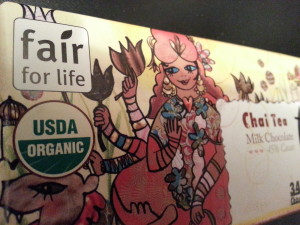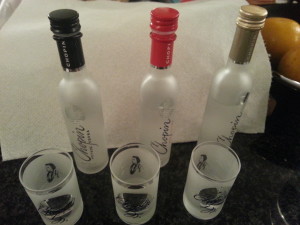 Remember when we found out that it was OK to eat chocolate? I mean when we were told that a little dark chocolate could be good for us? And remember that countless companies started producing dark chocolate, and everyone started raving about anything with a higher cocoa content. As usual with fads, a lot of it was hype. Just because 70% is written on a label, doesn’t mean the chocolate is good. Now, a few years later, many of us have learned that lesson.
Remember when we found out that it was OK to eat chocolate? I mean when we were told that a little dark chocolate could be good for us? And remember that countless companies started producing dark chocolate, and everyone started raving about anything with a higher cocoa content. As usual with fads, a lot of it was hype. Just because 70% is written on a label, doesn’t mean the chocolate is good. Now, a few years later, many of us have learned that lesson.
Another element in chocolate development was “fair trade.†Many people gobbled chocolate in order to help farmers at remote cocoa farms. And they did help. But again, not all of that chocolate was great.
Times have changed, and now we can get very good high-percent cocoa and fair trade all in one chocolate bar. Theo from 3400 Phinney Chocolate Factory has a selection of 45%, 50%, 70% plain and flavored chocolate bars that are incredibly tasty and wonderfully chocolaty. Some friends recently brought us a selection and so far I’ve tried the Bread & Chocolate, Hazelnut Crunch and Cocoa & Curry. One the clever ways Theo enhances their chocolates is by sprinkling some of the flavors with just enough salt to boost the chocolatiness (is that a word?). Very trendy – think salted caramel — and it works. (Thanks Beni & Matt.)
Blog
Tasting Wines Direct from the Vineyards: Estrella Farms

Recently I was invited to taste the wines made by Lee and Lorraine Steele, the owners of Estrella Farms in the Paso Robles region of California. Estrella’s grapes are mainly sold to some of the region’s most famous wineries: Justin Vineyards and Winery and Tablas Creek Vineyard.
The vineyards of Estrella Farms are planted only to cabernet sauvignon and syrah, and the Steeles make a couple wines from these grapes. Their own Cabernet Sauvignon goes into neutral French oak for 20 months before they hand-bottle the wine. They add 2% of their syrah to “tone down†the cab, and the wine is unfiltered.
Tasting this way, it was fascinating to see the features that stand out in Estrella’s wine: what Justin would value as blending elements. Estrella’s 2011 Cabernet Sauvignon was a pleasant aperitif wine. It had light, bright fruit — though a bit indistinct in flavor — and very little finish. (Justin, I assume, has other grapes to round out the finish in their wines.)
Estrella’s 2011 Syrah was a more balanced wine (with the addition of 5% of their own cabernet sauvignon), with good acidity and bright, cooked fruit and cocoa flavors, as well as some buttery toffee notes and a moderate finish. Most of Estrella’s syrah goes to Tablas Creek, a winery well-known for its Rhone-style blends, and this Estrella wine was a quality component, a nice wine in its own right.
Once Upon a Time in a Chianti Castle
Once upon a time…That’s how all stories about castles should begin. In this case, though, it’s about a winery castle – Castello Monsanto. So instead of “once upon a time†it’s “one day recently†I was invited to lunch with Laura Bianchi, one of the members of the family that bought the 18th century Castello Monsanto about 50 years ago. She was in the US to show her wines, which range in price from $14.99 to $52.99. After tasting, I found I liked them all.
 In any lineup, it’s tempting to lean toward the more expensive wines – or go countersnob and declare you love only the least expensive. But these were fairly equal in likeability for me. The 2010 Monrosso Chianti DOCG might have been a bit lighter than the 2010 Chianti Classico Riserva DOCG, which had some excellent blackberry notes. But all the wines, even the “Il Poggio†Chianti Classico Riserva DOCG and the 2003 Nemo Cabernet Sauvignon Toscana IGT (current vintage of this SuperTuscan) had lots of florals, some spice and earthiness in common.
In any lineup, it’s tempting to lean toward the more expensive wines – or go countersnob and declare you love only the least expensive. But these were fairly equal in likeability for me. The 2010 Monrosso Chianti DOCG might have been a bit lighter than the 2010 Chianti Classico Riserva DOCG, which had some excellent blackberry notes. But all the wines, even the “Il Poggio†Chianti Classico Riserva DOCG and the 2003 Nemo Cabernet Sauvignon Toscana IGT (current vintage of this SuperTuscan) had lots of florals, some spice and earthiness in common.
They just reminded me that I don’t drink enough wines from Tuscany these days…
How to use Your Holiday Gift Card: Two Great Accessories for Wine Travel
 If you’re taking a special bottle of wine to an event this year, you might want to invest in a VinniBag to carry it in your luggage. It’s inflatable and Made in USA!
If you’re taking a special bottle of wine to an event this year, you might want to invest in a VinniBag to carry it in your luggage. It’s inflatable and Made in USA!
With this accessory in my wheeled bag, I successfully toted wine on and off Amtrak and around New York City for the day, before arriving at my destination. (Yes, it’s a good idea NOT to juggle wine around very much, but in my case it wasn’t a priceless Bordeaux or Burgundy.)
COST: Around $25 each.
PRO: Cradled wine bottle well and did not leak; great for a really special bottle of wine
CON: Rather large thing to fit into a suitcase
 Wineskin is a re-sealable bubble-pack made of durable plastic, and it comes in several colors too. If you’re traveling to a wine region where you just might bring back a bottle or two, tuck a couple Wineskins into your suitcase before you leave. It’s a safer alternative to wrapping a bottle in your dirty laundry on the way back. And it’s smaller and lighter – more of a “just in case†option.
Wineskin is a re-sealable bubble-pack made of durable plastic, and it comes in several colors too. If you’re traveling to a wine region where you just might bring back a bottle or two, tuck a couple Wineskins into your suitcase before you leave. It’s a safer alternative to wrapping a bottle in your dirty laundry on the way back. And it’s smaller and lighter – more of a “just in case†option.
COST: Around $10 for a 2-pack.
PRO: Thin enough to carry with you on just about any trip, and it’s recyclable
CON: Wish it was resealable – and not made in China
3 Vodka Taste Test from Chopin: very smooth over all
When Chopin Vodka from Poland became widely available in the US, it was the first time I’d had a potato vodka I liked.
Because it had been some years since I’d really considered Chopin, I was interested when I heard they had a created a tasting kit which offered not only their traditional potato vodka, but also their wheat vodka and their rye. Each one is very smooth, but with marked differences in aromas and flavors.
Chopin’s black-topped potato vodka is the most neutral, with a slowly evolving flavor tinged with sweat pear and honey – on the whole a rounder flavor – with a mildly forceful alcohol finish.
The gold-capped Chopin wheat vodka was the least appealing at first, with a faint bitter aroma I identify more with chemicals than with spices. Toffee appears on the palate, and a bit of caraway infuses the finish.
The red-capped Chopin is actually rye, with a faint floral aroma. There’s a nice jelly-on-buttered toast element that deepens on the palate, into a very smooth version of rye whiskey.
AND if you’re in Poland, you can visit the distillery!
3 Wines to Pair with Winter Dinners — Newly Rediscovered
Chianti Classico. Originally a medium to light-bodied red for every-day dinners. Now a somewhat finer wine experience after years of upgrading quality in these vineyards and wineries in Tuscany. Chianti Classico is now a medium-bodied red with great aromatic components and lovely, rounded flavors backed by just enough structure to make you want to drink more –with food, of course. What vintages? You can find 2008 on the market along with 2009. It’s OK to hold either one for a few years, but start sampling them now. (Many are under $20.) Food pairings include lightly sauced pasta, game birds and plain roasted meat. 

Alsace wine for everyday: Remember these are the dry, white wines that are made to go with winter foods: pork, poultry, beef dishes, mild sausages, potatoes and other foods on the hearty (but not spicy) continuum. Whites include: Pinot Gris, Pinot Blanc, Riesling, and Gewurztramer. Had dinner with Anne Laure Helfrich this fall, and was reminded how much I like this region. Her family’s wines are affordable, too, in the $15 range.

Chateau Musar: Lebanon’s most famous winery is more French in style, whether they use Bordeaux, Rhone or Lebanese grapes. Their vintage-dated Red “Musar†tends to be cabernet sauvignon with cinsault and carignan, ranging from spiced herbs to silken earth when you taste from 2005 back to 1999 ($50-$65). Or start where Musar begins: with their red “Hochar†wine ($28), a similar blend, with fruit and spice on the palate; 2009 is the current vintage. Not having had this in Lebanon, I’ll stick to foods I know for pairings: herbed stews and winter soups, perhaps lamb and poultry too.